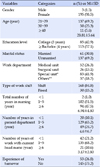1. Lee T, Kang KH, Ko YK, Cho SH, Kim EY. Issues and challenges of nurse workforce policy: A critical review and implication. Journal of Korean Academy of Nursing Administration. 2014; 20(1):106–116. DOI:
10.11111/jkana.2014.20.1.106.

2. Kim SY, Kim JK, Park KO. Path analysis for workplace incivility, empowerment, burnout, and organizational commitment of hospital nurses. Journal of Korean Academy of Nursing Administration. 2013; 19(5):555–564. DOI:
10.11111/jkana.2013.19.5.555.

3. Im SB, Lee MY, Kim SY. Nurses' perception of organizational commitment, nursing work environment, and social support in a general hospital. Journal of Korean Academy of Nursing Administration. 2015; 21(1):1–9. DOI:
10.11111/jkana.2015.21.1.1.

4. Kutney-Lee A, Stimpfel AW, Sloane DM, Cimiotti JP, Quinn LW, Aiken LH. Changes in patient and nurse outcomes associated with magnet hospital recognition. Medical Care. 2015; 53(6):550–557. DOI:
10.1097/MLR.0000000000000355.



5. Walker K, Fitzgerald K, Duff J. Supporting a healthy culture: Results of the Practice Environment Scale, Australia in a Magnet (R) designated hospital. Journal of Nursing Administration. 2014; 44(12):653–658. DOI:
10.1097/nna.0000000000000143.
6. Lee JC. The effects of perceived organizational support and leader-member exchange on members' attitudes and behaviors. Korean Journal of Business Administration. 2012; 25(3):1361–1377.
7. Dulebohn JH, Bommer WH, Liden RC, Brouer RL, Ferris GR. A meta-analysis of antecedents and consequences of leadermember exchange: integrating the past with an eye toward the future. Journal of Management. 2012; 38(6):1715–1759. DOI:
10.1177/0149206311415280.
8. Kim IS, Won SA, Kang SJ, Shin SM. The relationship among nurses' perception of super-leadership, self-leadership and organizational commitment. Journal of Korean Academy of Nursing Administration. 2016; 22(2):148–157. DOI:
10.11111/jkana.2016.22.2.148.

9. Lee AS, Yoon CK, Park JK. Effects of social support and ego-resilience on nursing performance of hospital nurses. Korean Journal of Occupational Health Nursing. 2012; 21(3):283–289. DOI:
10.5807/kjohn.2012.21.3.283.

10. Yom YH, Son HS, Lee HS, Kim MA. The relationship between physical discomfort, burnout, depression, social supports and emotional labor of clinical nurses in Korea. Journal of Korean Clinical Nursing Research. 2017; 23(2):222–235. DOI:
10.22650/JKCNR.2017.23.2.222.
11. Aiken LH, Clarke SP, Sloane DM, Lake ET, Cheney T. Effects of hospital care environment on patient mortality and nurse outcomes. Journal of Nursing Administration. 2008; 38(5):223–229. DOI:
10.1097/01.NNA.0000312773.42352.d7.

12. Cho E, Choi M, Kim EY, Yoo IY, Lee NJ. Construct validity and reliability of the Korean version of the practice environment scale of nursing work index for Korean nurses. Journal of Korean Academy of Nursing. 2011; 41(3):325–332. DOI:
10.4040/jkan.2011.41.3.325.


13. Kim RA, Kim IH. A study on relationship among quality of LMX, self-concept and organization effectiveness. Journal of Management & Organization. 2004; 28(4):171–213.
14. Liden RC, Maslyn JM. Multidimensionafity of leader-member exchange: An empirical assessment through scale development. Journal of Management. 1998; 24(1):43–72. DOI:
10.1177/014920639802400105.

15. Park JW. A study to development a scale of social support [dissertation]. Seoul: Yonsei University;1985.
16. Kim KH. The relationship of self-efficacy and social support on burnout of insurance review nurses [master's thesis]. Seoul: Hanyang University;2008.
17. Mowday RT, Steers RM, Porter LW. The measurement of organizational commitment. Journal of Vocational Behavior. 1979; 14(2):224–247. DOI:
10.1016/0001-8791(79)90072-1.

18. Kwon JO, Kim EY. Impact of unit-level nurse practice environment on nurse turnover intention in the small and medium sized hospitals. Journal of Korean Academy of Nursing Administration. 2012; 18(4):414–423. DOI:
10.11111/jkana.2012.18.4.414.

19. Korean Hospital Nurses Association. A survey on hospital nursing staffing (2015). Business report for Hospital Nurses Association. Seoul: Korean Hospital Nurses Association;2015.
20. Korea Health Industry Development Institute. 2014 Medical resources statistics handbook. Chungju: Korea Health Industry Development Institute;2014.
21. Lee MH, Kim JK. A comparative study on nursing practice environment, professionalism, and job satisfaction according to hospital size. Journal of Korean Academy of Nursing Administration. 2013; 19(4):470–479. DOI:
10.11111/jkana.2013.19.4.470.

22. Korean Hospital Nurses Association. A survey on hospital nursing staffing(2013). Business report for Hospital Nurses Association. Seoul: Hospital Nurses Association;2013.
23. Korean Hospital Nurses Association. A survey on hospital nursing staffing(2014). Business report for Hospital Nurses Association. Seoul: Korean Hospital Nurses Association;2014.
24. Park SK, Cho KM, Jwa YG, Kang DW, Lee YJ. Survey of nurse activity status. Chungju: Korea Health Industry Development Institute;2014.
25. Yi HH, Yi YJ. Influence of leader-member exchange quality of head nurses and clinical nurses on organizational commitment and job satisfaction in clinical nurses. Journal of Korean Academy of Nursing Administration. 2014; 20(2):195–205. DOI:
10.11111/jkana.2014.20.2.195.

26. Woo HJ. The relationship between social support and nursing performance among Korean clinical nurses [master's thesis]. Suwon: Ajou University;2014.
27. Eo YS. Path analysis of empowerment, social support, organizational commitment, burnout, and turnover intention among nurses. Journal of the Korean Data Analysis Society. 2015; 17(3):1683–1697.
28. Hwang KS. Effect of social capital on Goendang culture(a traditional community culture on Jeju) and local development. Journal of the Korea Academia-Industrial Cooperation Society. 2015; 16(3):1764–1772. DOI:
10.5762/KAIS.2015.16.3.1764.
29. Park GJ, Kim YN. Factors influencing organizational commitment among hospital nurses. Journal of Korean Academy of Nursing Administration. 2010; 16(3):250–258. DOI:
10.11111/jkana.2010.16.3.250.

30. Kim SJ, Choi SB. The effects of emotional leadership, leader trust and leader—member exchange on organizational commitment: evidence from university hospital nurses. Korean Business Education Review. 2015; 30(2):1–33.






 PDF
PDF ePub
ePub Citation
Citation Print
Print






 XML Download
XML Download